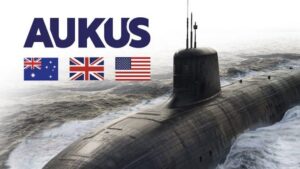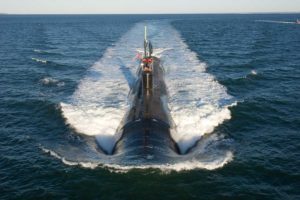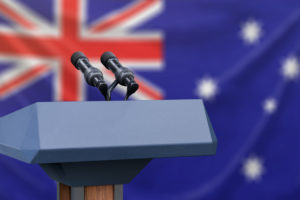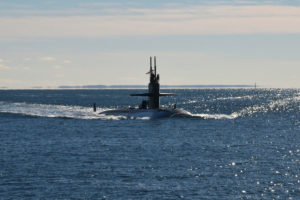The decision by Australia to acquire nuclear-powered submarines (SSNs) as part of the AUKUS agreement offers the potential for a major boost in Australian naval capability. However, as has been evident from the moment of the announcement, there are significant challenges facing such an acquisition. In order to understand these challenges, it is necessary to look back at the troubled history of the efforts to design and build a successor to Australia’s current Collins-class submarines.
What Type of Submarine?
When the first details of the proposed Australian Future Submarine programme were set out in the 2009 Defence White Paper, it was specified that the new vessels were to be superior in all respects to the submarines they were replacing. They needed to have greater range, longer endurance, higher transit speeds, and be equipped to undertake a wide variety of missions. The only existing vessels that came close to meeting such criteria were SSNs, but nuclear propulsion was explicitly ruled out by the then-Labor government. This led some defence commentators to quip that Australia wanted a “conventionally powered nuclear submarine.” The requirement that the submarines be equipped with American weapons and a derivative of the American combat system added further complexity to the choice of design because the United States only operates nuclear-powered submarines.
Recent revelations about the origins of AUKUS have raised additional questions about the precise role envisaged for the Australian Future Submarine. Since the 2009 White Paper, there has been mention of a “strategic strike” capability, but there was little emphasis placed upon this. Earlier this year, the Sydney Morning Herald claimed that a key driver of the decision to pursue nuclear submarines was Australia’s desire to acquire “the power to pose a direct threat to China’s forces and the Chinese mainland.” This fits with more recent discussion of the submarines, which has frequently described them as a deterrent. Any such shift in the expected roles of the submarines, away from sea denial and toward strike, further tilts the balance in favour of nuclear propulsion because of the requirement for greater size and endurance.
Thus, in many ways, SSNs have always been the obvious choice to meet the criteria set out by Defence and successive governments (although doubts exist over whether these requirements have been properly evaluated). Real questions, however, remain. These range from the ability of the Royal Australian Navy to sustain sufficient submariners to crew the vessels through to the reactions of Australians living near the bases and sites of construction. The sudden decision to shift from conventional to nuclear submarines, and the extremely secretive nature of the process, means that few of these issues have been fully worked through. One of the most significant risks for the AUKUS submarine programme is that the decision to exclude consideration of nuclear propulsion, made by successive Australian governments dating back to the 1960s, was made for good reasons.
When Is It Needed?
Serious discussion of Australia’s future submarine requirements began in the mid-2000s, just as the last of the Collins-class were being commissioned. The timelines for the acquisition were always dictated by the need to provide a continuous submarine capability once the Collins-class vessels started reaching the end of their lives. The life-of-type for the Collins submarines was designed to be 28 years, so they would start to retire in 2024. For this reason, the early forecasts had construction of the new submarines starting around 2016, giving time for build, workup, and becoming operational. Following the release of the 2009 White Paper, little visible progress was made, and by 2012, there were real concerns over the likelihood of a capability gap. In response to this, the Department of Defence conducted a review and concluded that the Collins vessels could undergo a major refit called a life-of-type extension (LOTE), giving them a further seven years. Over the following years, there was much discussion about the nature of the LOTE process, and as the future submarine programme experienced further delays, the number of boats to be upgraded and the length of additional lifespan grew in order to prevent a capability gap opening up. In 2021, the Defence Minister admitted that all six Collins-class boats would have to undergo a LOTE, with the first boat starting in 2026. This can be seen as a 2+10 process, with a two-year refit providing an additional 10 years of life. This means that the first Collins-class submarine is now scheduled to retire in 2038.
The complex story of efforts to upgrade the Collins-class is significant because the date of decommissioning dictates delivery dates for the new submarines. It is no coincidence that in announcing the AUKUS deal, the Morrison government stated that the first of the submarines would be in the water ‘before the end of the next decade,’ with the date 2038 being almost universally used. This timeframe has always appeared ambitious, and with the change of government, it has been revealed that the Department of Defence itself does not expect the submarines until sometime in the 2040s. This has once again opened up the prospect of a major capability gap, and the Navy has been forced to admit it is looking at a further extension to the life of the Collins-class beyond the LOTE period. The new government is also considering interim capabilities to plug the gap, but the stated aim remains to acquire the AUKUS submarines as quickly as possible. The problem is that Australia’s plunge into nuclear submarines is badly timed, both in terms of the design options and the capability of the AUKUS partners to provide support. This leaves few good options if Australia remains committed to getting SSNs into the water as soon as possible.
Diplomatic Travails
The timeline problems facing the Australian submarine programme are mirrored by the diplomatic issues. From the outset, the choices over which company—and nation—to partner with have been controversial. The early decision to exclude the Swedes, who had partnered with Australia on the Collins build, left SAAB and the Swedish government unimpressed and many commentators confused. In 2015, it briefly appeared that then-Prime Minister Tony Abbott was going to award the submarine contract to Japan without a competitive evaluation process (CEP). This so-called Option J was based upon the close relationship between Abbott and his Japanese counterpart, Shinzo Abe, and would have seen the submarines built in Japan. Abe invested considerable political capital in the project, and it appeared to have been a done deal before Australian domestic politics got in the way. Abbott was facing a significant leadership challenge within his own party and is reputed to have changed tack and promised a full CEP in order to secure key votes.
The CEP was run through 2015 and 2016, with designs from France, Germany, and Japan in the running. At the end of the process, the French clinched the deal, which left the Germans and the Japanese disappointed. The Germans were particularly frustrated, as they felt that the decision-making process was opaque and they were unclear as to why they lost. It has even been reported that the Germans were initially told that they had won the contract before a last-minute meeting of the National Security Committee reversed the call. For the French, the decision was lauded as the “contract of the century,” and domestically, it was seen as a huge political success. Others acclaimed the way it cemented the connection between leading Indo-Pacific powers. This, of course, did not last, and relations between Australia and France became frosty long before the shock decision to cancel the contract.
The AUKUS announcement led to bitter recriminations, including the withdrawal of the French ambassador and President Macron’s public accusation that then-Prime Minster Scott Morrison had lied to him. The decision to acquire nuclear submarines has also been viewed with considerable scepticism by other powers in Australia’s region, and Indonesia recently raised concerns about the potential nuclear proliferation risk.
Many of these damaged relationships have since been patched up, and the commercial nature of the deals has meant that some, such as Germany’s TKMS, have even expressed interest in competing for any interim submarine capability that Australia may decide to purchase. There has, however, been significant damage done to Australia’s reputation both as a trusted partner and as a power capable of managing major defence acquisitions. For this reason, most people agree that Australia cannot afford another high-profile failure. This issue of creditability is further accentuated by the uncertain nature of the AUKUS partnership. While it is not an alliance, this is far more than a simple defence contract, and, right or wrong, it has come to be seen as a direct response to Chinese influence in the region. AUKUS is about more than just submarines, but if this aspect of the programme were to fail, it would have implications for Australia’s strategic position far beyond the absence of that specific capability.
Who Should Build It and How Much Will It Cost?
One of the constant debates over the future submarine project has been whether it should be built in Australia. In the original 2009 White Paper, the Labor government committed to “assemble” the boats in South Australia, although no one seemed certain as to exactly what that meant. The Liberal party, which took power in 2013, were not quite as explicit, and as late as the 2016 Defence White Paper, they had merely committed to “maximising Australian industry involvement.” However, as Abbott’s Option J experience revealed, building overseas was extremely problematic politically. This was in spite of the fact that building the Collins-class vessels in Australia had been a difficult process and they were frequently derided as being “dud subs.” The more recent history of Australian naval shipbuilding did little to reassure the sceptics, and in 2014, the Defence Minister attacked ASC, the government-owned shipyard, declaring he “wouldn’t trust them to build a canoe.” However, politics were always likely to trump these concerns, and the decision was made to build the French-designed Attack-class submarines in Adelaide. Indeed, questions over the level of Australian industry involvement dogged the project and generated much bad blood between the French shipbuilder and the Australians.
The question of cost is another that has vexed those analysing the future submarine project. While there is little clarity over many of the figures used, it is apparent that the decision to acquire the French-designed boats was taken in spite of their considerably high cost, and that there was then a dramatic escalation in cost shortly following that decision. The lack of clarity from Defence over these numbers, and the decision-making process that lies behind them, has arguably bordered on obfuscation, and considering the department’s wider record on acquisitions, this does little to promote trust.
For the AUKUS submarine project to be a success, certain key steps are essential. The first is an honest assessment of exactly what capability Australia desires and when it can be delivered. This will then inform decisions about interim solutions to fill the likely capability gap. It is also important that Australia works hard to patch up the diplomatic relationships that have been strained by the tortuous submarine acquisition process. This is significant not only in terms of gaining acceptance of what is a contentious military acquisition but also in regard to cementing relationships with key Indo-Pacific partners, something essential to achieving the wider aims of AUKUS. Arguably the most important factor determining the success of the AUKUS submarine project, however, will be its ability to generate sustained support from the Australian public. There will be difficult questions over how much of the work is completed in Australia, and appropriately managing the interface between defence acquisition and domestic politics will be challenging. Furthermore, given the extraordinary, as yet unknown cost of the new nuclear submarines, it appears essential that there be considerably greater transparency than that which has marked previous efforts. Key reviews of the problems that beset the construction of the Collins-class vessels emphasized the critical importance of greater openness and engagement with both politicians and the wider public. If the domestic political challenges facing the AUKUS submarine programme are to be overcome, it is essential that such advice is heeded.










